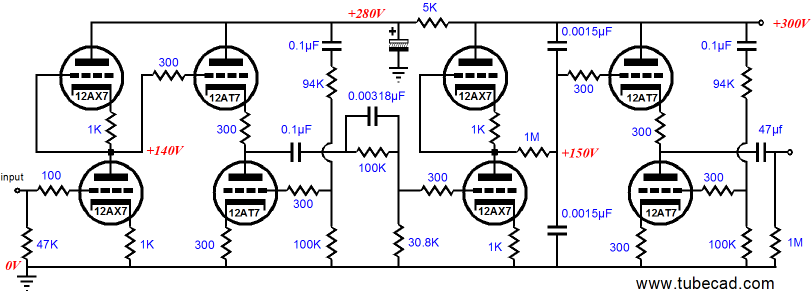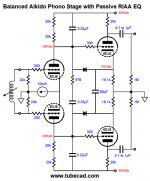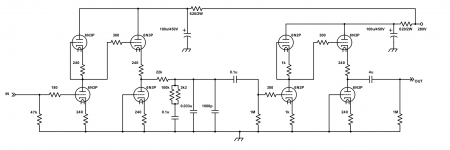I think it's four triodes too many 🙂
I also think that a more detailed opinion requires more details... like desired tube type, intended cartridge, etc.
I say, lose the active loads, and run subminiature 6N16B for cathode followers and concertina, and 6N17B for gain. It would have excellent performance, and be rather compact, too. Great curves on those little tubes.
I also think that a more detailed opinion requires more details... like desired tube type, intended cartridge, etc.
I say, lose the active loads, and run subminiature 6N16B for cathode followers and concertina, and 6N17B for gain. It would have excellent performance, and be rather compact, too. Great curves on those little tubes.
Koda, if you are going to do the EQ in one go, then you need, ideally, a fair bit of gain in the first stage; were you planning to use 6N2P?
I used a completely balanced tube phonostage for nearly 10 years (now I use similar circuitry with transistors). Connecting the hot and cold to the grids of the first differential pair is a very natural way to interface with the cartridge and Miller C is halved. What is said about the 3dB noise penalty is a complete non issue when you consider the immunity to power supply noise or any other external interference. I used the Soviet 6S3P-EV, which is an absolutely terrific valve, for the input stage. I also used split EQ as I needed to play 78's as well as many early non-RIAA monos.
Ligwendil, I have used 6N16B myself for concertina. How is the linearity of the 6N17B?
I had almost forgotten, I also have built a completely balanced phono for my father with four 6F12P only with triode wired pentode section as the output. Because the transconductance of both sections is high, you can actually get away without followers.
I used a completely balanced tube phonostage for nearly 10 years (now I use similar circuitry with transistors). Connecting the hot and cold to the grids of the first differential pair is a very natural way to interface with the cartridge and Miller C is halved. What is said about the 3dB noise penalty is a complete non issue when you consider the immunity to power supply noise or any other external interference. I used the Soviet 6S3P-EV, which is an absolutely terrific valve, for the input stage. I also used split EQ as I needed to play 78's as well as many early non-RIAA monos.
Ligwendil, I have used 6N16B myself for concertina. How is the linearity of the 6N17B?
I had almost forgotten, I also have built a completely balanced phono for my father with four 6F12P only with triode wired pentode section as the output. Because the transconductance of both sections is high, you can actually get away without followers.
Last edited:
Or maybe this?
Balanced in to out. Use with a LOMC cart. and SUT. Might get away without grounding the SUT primary. Just a thought.
Balanced Systems & Going Horizontal
Steve
Balanced in to out. Use with a LOMC cart. and SUT. Might get away without grounding the SUT primary. Just a thought.
Balanced Systems & Going Horizontal
Steve
Attachments
Thanks for the opinions... As it stands it's built as in the attached schematic. It's an excellent amp. I was just thinking of a way to make it balanced for someone I know...
Piano3: I love the 6F12P.
Piano3: I love the 6F12P.
Attachments
Last edited:
You need *three* cathode followers:
1) drive the EQ with a low impedance
2) drive the output with a low impedance
3) drive the other output with a low impedance
IMHO low-Z line drive is MUCH more important than "balanced", at least until the signal leaves the room and runs down the street.
Or put a triode-strap 6V6 on the end with a 10K:600 transformer.
1) drive the EQ with a low impedance
2) drive the output with a low impedance
3) drive the other output with a low impedance
IMHO low-Z line drive is MUCH more important than "balanced", at least until the signal leaves the room and runs down the street.
Or put a triode-strap 6V6 on the end with a 10K:600 transformer.
Attachments
For a buck more you could make both outputs White Cathode Followers and get seriously low Zout and double the output current swing.
The circuit reminds me of the Aikido phono preamp by John Broskie, the single ended version. You can tweak your circuit to use the Aikido cathode follower so you can some noise cancellation.


interesting, huge signal gain ( full bandwidth ) with attenuation at the final buffer stage. lowest possible noise with tubes. I also like the high signal levels 10mv @ 10khz * 5000 = 50v p-p. Assuming 12ax7 srpp gain = 70 single RIAA Resistor/ capacitor EQ is more like NAB tape EQ. 10 db boost from 3180pf || 100k resistor brings it into compliance ?
The circuit reminds me of the Aikido phono preamp by John Broskie, the single ended version. You can tweak your circuit to use the Aikido cathode follower so you can some noise cancellation.

It's based on the Aikido but without the noise cancelling since I no need for it.
You need *three* cathode followers:
1) drive the EQ with a low impedance
2) drive the output with a low impedance
3) drive the other output with a low impedance
IMHO low-Z line drive is MUCH more important than "balanced", at least until the signal leaves the room and runs down the street.
Or put a triode-strap 6V6 on the end with a 10K:600 transformer.
My calculations tell me the Zout of the one I've built is about 500R... The amp has a 1M input. If I wanted lower Zout, I could use a 6N6P instead of the 6N3P, and make the output push pull (in my headphone amp, the 6N6P drives 32R headphones)
The newer (a year or two ago) Aikido is essentially the same but some of the details, notably around the RIAA compensation, are a bit different.
Steve
Steve
- Status
- Not open for further replies.
- Home
- Amplifiers
- Tubes / Valves
- Balanced RIAA Phono



